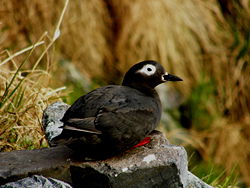- Spectacled Guillemot
-
Spectacled Guillemot 
Conservation status Scientific classification Kingdom: Animalia Phylum: Chordata Class: Aves Order: Charadriiformes Family: Alcidae Genus: Cepphus Species: C. carbo Binomial name Cepphus carbo
Pallas, 1811The Spectacled, or Sooty Guillemot, Cepphus carbo, is a seabird in the auk family.
Contents
Description
This species is about 38 cm (15") long, with red legs, black bill and a blackish iris.
The breeding adult Spectacled Guillemot is distinctive, mostly plumaged dull sooty-black except for conspicuous white 'spectacles' on the face
In adult non-breeding plumage, the underparts are white, uniformly tipped very pale grey-brown. Transitional birds are like breeding adults, except the underparts are scaled with white.
Sexes are alike, but juveniles are separable from adults. There are no subspecies.
Range
The Spectacled Guillemot's range is restricted to the northwestern Pacific Ocean: throughout the Sea of Okhotsk and the Kuril Islands in Russia and on the northern island of Hokkaidō in Japan. Its range overlaps with that of the closely related Pigeon Guillemot, though it extends further north.[1]
Notes
- ^ (Russian) Artyukhin Yu.B. and V.N. Burkanov (1999). Sea birds and mammals of the Russian Far East: a Field Guide, Мoscow: АSТ Publishing – 215 p.
References
Peter Harrison, Seabirds An Identification Guide ISBN 0-395-60291-2
Categories:- IUCN Red List least concern species
- Cepphus
- Guillemots
Wikimedia Foundation. 2010.

